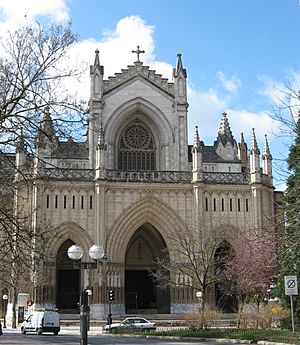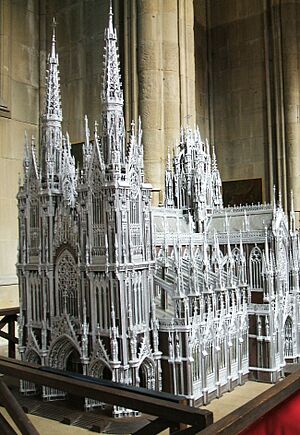Cathedral of María Inmaculada of Vitoria facts for kids
Quick facts for kids Cathedral of María Inmaculada of Vitoria |
|
|---|---|
| Native names Spanish: Catedral de María Inmaculada de Vitoria Basque: Maria Sortzez Garbiaren katedrala |
|
 |
|
| Location | Vitoria-Gasteiz, Spain |
| Area | Lovaina |
| Built | 1907-1914, 1946-1969 |
| Architect | Julián de Apraiz and Javier de Luque (first period) Miguel de Apraiz Barreiro and Antonio Camuñas Paredes (second period) |
| Official name: Maria Sortzez Garbiaren Katedrala (eu) / Catedral de María Inmaculada de Vitoria (es) | |
| Type | Non-movable |
| Criteria | Monument |
| Lua error in Module:Location_map at line 420: attempt to index field 'wikibase' (a nil value). | |
The Cathedral of María Inmaculada de Vitoria is a beautiful church in Vitoria-Gasteiz, Spain. People often call it the "New Cathedral." It is a Roman Catholic church built in the early 1900s. The cathedral is designed in a style called Neogothic. This means it looks like older Gothic churches.
Contents
Building the Cathedral
First Steps (1907-1914)
Work on the cathedral started on August 4, 1907. It was built where an old convent used to be. The first plans were made by architects Julián Apraiz and Javier de Luque. Bishop José Cadena y Eleta also helped start the project.
Finishing the Work (1946-1969)
For many years, the cathedral was not finished. People even called the unfinished parts "ruins." Building work started again in 1946, after the Spanish Civil War ended. Bishop Carmelo Ballester Nieto helped with money. Miguel de Apraiz Barreiro, Julián's son, led the building work.
The construction moved slowly. Builders kept the original style. But they also used new materials like concrete and artificial stone. These new materials made the building lighter and stronger.
By 1949, parts like the ambulatory were finished. In 1952, more sections were built, including a low tower. Between 1960 and 1963, windows from the first building period were put in. Reliefs by artist Enrique Monjo were also added.
The rest of the cathedral was covered between 1964 and 1969. New materials meant they did not need outside supports. The church was officially opened on September 24, 1969. Many important people attended the ceremony. The work was fully completed in 1973.
About the Cathedral
This cathedral is very large and impressive. It has five long sections called naves. There is also a wide cross-section and many small chapels. The building is 118 meters long. It is 62 meters wide at its widest point. The highest part is 35 meters tall.
It is the second largest church in Spain. Only the Cathedral of Seville is bigger. The cathedral's shape looks like a Latin cross. It covers an area of 5,750 square meters. It is big enough to hold many thousands of people inside.
See also



